
Jaisalmer Golden Fort Commonly referred to as Sonar Quila or Sone ka Quila (Golden Fort), Jaisalmer Fort is a stunning architectural wonder and one of the largest forts in the world, located in Jaisalmer, Rajasthan. This fort, the second oldest in Rajasthan, proudly displays its majestic beauty. Constructed from yellow sandstone, its walls gleam bright gold under the daytime sun, softening into a rich honey-gold at sunset—earning it the title of Golden Fort.
Perched on Trikuta Hill amidst the vast Thar Desert, the fort has witnessed countless battles over the centuries. Jaisalmer, often called the Golden City, offers a unique blend of nomadic desert culture and royal heritage, promising an experience unlike any other.











